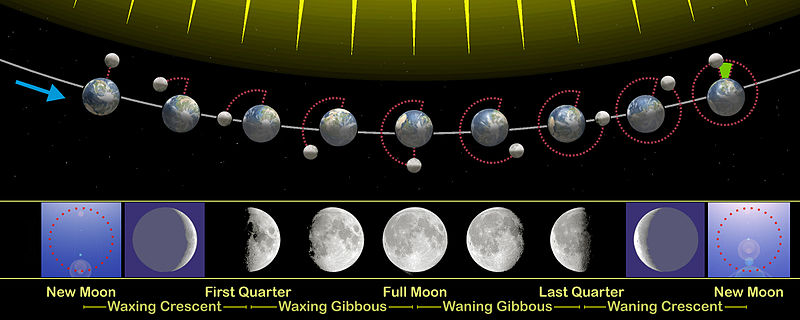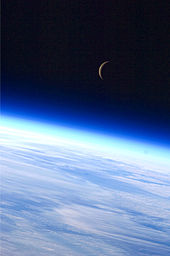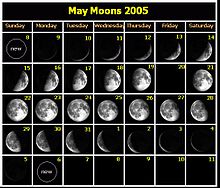- Lunar phase
-
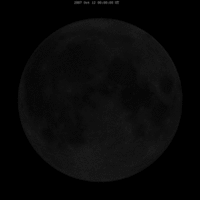 Animation of the Moon as it cycles through its phases, as seen from the Northern Hemisphere. The apparent wobbling of the Moon is known as libration. The apparent change in size is due to the eccentricity of the lunar orbit.
Animation of the Moon as it cycles through its phases, as seen from the Northern Hemisphere. The apparent wobbling of the Moon is known as libration. The apparent change in size is due to the eccentricity of the lunar orbit.
A lunar phase or phase of the moon is the appearance of the illuminated (lighted) portion of the Moon as seen by an observer, usually on Earth. The lunar phases change cyclically as the Moon orbits the Earth, according to the changing relative positions of the Earth, Moon, and Sun. One half of the lunar surface is always illuminated by the Sun (except during lunar eclipses), and hence is bright, but the portion of the illuminated hemisphere that is visible to an observer can vary from about 100% (full moon) to 0% (new moon). The lunar terminator is the boundary between the illuminated and unilluminated hemispheres.
Contents
Overview
 The lunar phase depends on the Moon's position in orbit around the Earth and the Earth's position in orbit around the sun. This diagram (not to scale) looks down on Earth from north. Both Earth and the Moon's orbit are rotating counter-clockwise. Sunlight (yellow arrows) is coming in from the right. One can see, for example, that the full moon will always rise at sunset and that the waning crescent moon is high overhead around 9:00 am local time.
The lunar phase depends on the Moon's position in orbit around the Earth and the Earth's position in orbit around the sun. This diagram (not to scale) looks down on Earth from north. Both Earth and the Moon's orbit are rotating counter-clockwise. Sunlight (yellow arrows) is coming in from the right. One can see, for example, that the full moon will always rise at sunset and that the waning crescent moon is high overhead around 9:00 am local time.
Lunar phases are the result of looking at the illuminated half of the Moon from different viewing geometries; they are not caused by the shadow of the Earth or umbra falling on the Moon's surface (this occurs only during a lunar eclipse).
The Moon exhibits different phases as the relative position of the Sun, Earth and Moon changes, appearing as a full moon when the Sun and Moon are on opposite sides of the Earth and as a new moon (dark moon) when they are on the same side. The phases of full moon and new moon are examples of syzygies, which occur when the Earth, Moon, and Sun lie (approximately) in a straight line. The time between two full moons (a Lunar month) is about 29.53 days[1] (29 days, 12 hours, 44 minutes) on average (hence, the concept of the time frame of an approximated month was derived). This synodic month is longer than the time it takes the Moon to make one orbit around the Earth with respect to the fixed stars (the sidereal month), which is about 27.32 days.[1] This difference is caused by the fact that the Earth-Moon system is orbiting around the Sun at the same time the Moon is orbiting around the Earth.
The actual time between two syzygies or two phases is quite variable because the orbit of the Moon is elliptic and subject to various periodic perturbations, which change the velocity of the Moon. When the moon is closer to the earth, it moves faster; when it is farther, it moves slower. The orbit of the Earth around the Sun is also elliptic, so the speed of the Earth also varies, which also affects the phases of the Moon.[2]
It might be expected that once every month when the Moon passes between Earth and the Sun during a new moon, its shadow would fall on Earth causing a solar eclipse. Likewise, during every full moon one might expect the Earth's shadow to fall on the Moon, causing a lunar eclipse. Solar and lunar eclipses are not observed every month because the plane of the Moon's orbit around the Earth is tilted by about five degrees with respect to the plane of Earth's orbit around the Sun (the plane of the ecliptic). Thus, when new and full moons occur, the Moon usually lies to the north or south of a direct line through the Earth and Sun. Although an eclipse can only occur when the Moon is either new or full, it must also be positioned very near the intersection of Earth's orbit plane about the Sun and the Moon's orbit plane about the Earth (that is, at one of its nodes). This happens about twice per year, and so there are between four and seven eclipses in a calendar year. Most of these are quite insignificant; major eclipses of the Moon or Sun are rare.
Names of lunar phases
The phases of the Moon have been given the following names, in sequential order:
Phase Northern Hemisphere Southern Hemisphere Visibility Standard time of culmination (mid-phase) New moon Not visible, traditionally Moon's first visible crescent after sunset 12 noon Waxing crescent moon Right 1–49% visible Left 1–49% visible afternoon and post-dusk 3 pm First quarter moon Right 50% visible Left 50% visible afternoon and early night 6 pm Waxing gibbous moon Right 51–99% visible Left 51–99% visible late afternoon and most of night 9 pm Full moon Fully visible Fully visible sunset to sunrise (all night) 12 midnight Waning gibbous moon Left 51–99% visible Right 51–99% visible most of night and early morning 3 am Third quarter moon Left 50% visible Right 50% visible late night and morning 6 am Waning crescent moon Left 1–49% visible Right 1–49% visible pre-dawn and morning 9 am Dark moon Not visible, traditionally Moon's last visible crescent before sunrise 12 noon When the Sun and Moon are aligned on the same side of the Earth the Moon is "new", and the side of the Moon visible from Earth is not illuminated by the Sun. As the Moon waxes (the amount of illuminated surface as seen from Earth is increasing), the lunar phases progress from new moon, crescent moon, first-quarter moon, gibbous moon and full moon phases, before returning through the gibbous moon, third-quarter (or last quarter) moon, crescent moon and new moon phases. The terms old moon and new moon are interchangeable, although new moon is more common. Half moon is often used to mean the first- and third-quarter moons, while the term 'quarter' refers to the extent of the moon's cycle around the Earth, not its shape.
When a sphere is illuminated on one hemisphere and viewed from a different angle, the portion of the illuminated area that is visible will have a two-dimensional shape defined by the intersection of an ellipse and circle (where the major axis of the ellipse coincides with a diameter of the circle). If the half-ellipse is convex with respect to the half-circle, then the shape will be gibbous (bulging outwards), whereas if the half-ellipse is concave with respect to the half-circle, then the shape will be a crescent. When a crescent Moon occurs, the phenomenon of Earthshine may be apparent, where the night side of the Moon faintly reflects light from the Earth.
In the northern hemisphere, if the left side of the Moon is dark then the light part is growing, and the Moon is referred to as waxing (moving towards a full moon). If the right side of the Moon is dark then the light part is shrinking, and the Moon is referred to as waning (moving towards a new moon). Assuming that the viewer is in the northern hemisphere, the right portion of the Moon is the part that is always growing (i.e., if the right side is dark, the Moon is growing darker; if the right side is lit, the Moon is growing lighter). In the southern hemisphere the Moon is observed upside down (compared with viewing from the northern hemisphere), and the opposite sides appear to grow (wax) and shrink (wane).
Calendar
The average calendrical month, which is 1/12 of a year, is about 30.44 days, while the Moon's phase (synodic) cycle repeats on average every 29.53 days. Therefore the timing of the Moon's phases shifts by an average of almost one day for each successive month. Photographing the Moon's phase every day for a month, starting in the evening after sunset, and repeating approximately 25 minutes later each successive day, ending in the morning before sunrise, would create a composite image like the example calendar from May 8, 2005, to June 6, 2005. There is no picture on May 20 since a picture would be taken before midnight on May 19, and after midnight on May 21. Similarly, on a calendar listing moon rise or set times, some days will appear to be skipped. When the Moon rises just before midnight one night it will rise just after midnight the next (so too with setting). The 'skipped day' is just a calendar artifact and not the Moon behaving strangely.
Calculating phase
The approximate age of the moon, and hence the approximate phase, can be calculated for any date by calculating the number of days since a known new moon (such as January 1, 1900 or August 11, 1999) and reducing this modulo 29.530588853 (the length of a synodic month). The difference between two dates can be calculated by subtracting the Julian Day Number of one from that of the other, or there are simpler formulae giving (for instance) the number of days since December 31, 1899. This calculation of course assumes a perfectly circular orbit and hence may be incorrect by several hours (it also becomes less accurate the larger the difference between the required date and the reference date); it is accurate enough to use in a novelty clock application showing moon phase, but specialist usage taking account of lunar apogee and perigee requires a more elaborate calculation.
See also
- Blue moon
- Lunaception
- Lunar effect
- Observing the Moon
- Planetshine
- Seven-day week
- Tides
- Week
References
- ^ a b Pamela J. W. Gore (1996-01-22). "Phases of the Moon". Georgia Perimeter College. http://facstaff.gpc.edu/~pgore/astronomy/astr101/moonphas.htm. Retrieved 2010-06-14.
- ^ Timing of moon phases
External links
General
- Six Millennium Catalog of Phases of the Moon hosted by NASA]
- Virtual Reality Moon Phase
- US Naval Service on Moon Phase / What the Moon Looks Like Today (United States Naval Observatory)
- Full Moon Names
- Telescopic moon photos through the phases by Michael Myers
- The Moon Below the Equator
- Current Moon Phase
- The Length of the Lunar Cycle (numerical integration analysis)
Educational aids
- Starchild: Moonlight Madness Lunar Phases Game
- Names and Images of the 8 moon phases
- Quia 3rd Grade SOL 3.8 – Put the Moon's Phases in the Correct Order Game
- Astrophysics Science Project Integrating Research & Education: Lunar Phases Quiz
The Moon Physical features 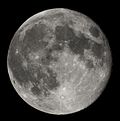
Orbit Lunar surface - Selenography
- Near side
- Far side
- Lunar mare
- (List)
- Craters
- (List)
- Mountains
- Valleys
- South Pole – Aitken basin
- Shackleton crater
- Water
- Soil
- Peak of eternal light
- Space weathering
- Transient lunar phenomenon
Lunar science Exploration Other topics - See also Solar System
- Natural satellite
Categories:- Phases of the Moon
- Observational astronomy
- Technical factors of astrology
Wikimedia Foundation. 2010.

